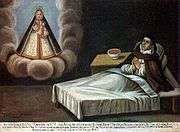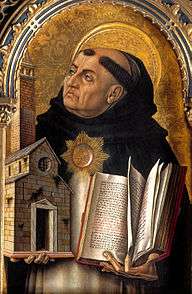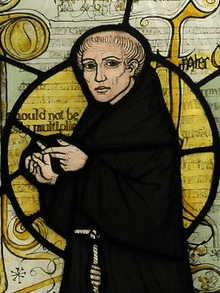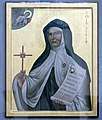Edith Stein
Edith Stein (religious name Teresia Benedicta a Cruce OCD; also known as St. Edith Stein or St. Teresa Benedicta of the Cross; 12 October 1891 – 9 August 1942) was a German Jewish philosopher who converted to Catholicism and became a Discalced Carmelite nun. She is canonized as a martyr and saint of the Catholic Church, and she is one of six co-patron saints of Europe.
Edith Stein OCD | |
|---|---|
.jpg) Stein in 1938 or 1939 | |
| Born | 12 October 1891 |
| Died | 9 August 1942 (aged 50) Auschwitz-Birkenau, German-occupied Poland |
| Cause of death | Execution by poisonous gas |
| Nationality | German |
| Alma mater | Schlesische Friedrich-Wilhelms-Universität University of Freiburg University of Göttingen |
Notable work |
|
| Era | 20th-century philosophy |
| Region | Western philosophy |
| School | Continental philosophy Phenomenology Thomism |
| Institutions | University of Freiburg |
Main interests | Metaphysics, phenomenology, philosophy of mind and epistemology |
Notable ideas |
|
Influences
| |
Influenced
| |
St. Teresa Benedicta of the Cross OCD | |
|---|---|
.jpg) | |
| Religious and martyr | |
| Venerated in | Catholic Church |
| Beatified | 1 May 1987, Cologne, Germany by Pope John Paul II |
| Canonized | 11 October 1998, Vatican City by Pope John Paul II |
| Feast | 9 August |
| Attributes | Yellow Star of David on a Discalced Carmelite nun's habit, flames, a book |
| Patronage | Europe; loss of parents; converted Jews; martyrs; World Youth Day[4] |
| Part of a series on | |||||||||||||||||||||||||||||
| Christian mysticism | |||||||||||||||||||||||||||||
|---|---|---|---|---|---|---|---|---|---|---|---|---|---|---|---|---|---|---|---|---|---|---|---|---|---|---|---|---|---|
 | |||||||||||||||||||||||||||||
|
Theology · Philosophy
|
|||||||||||||||||||||||||||||
|
Practices
|
|||||||||||||||||||||||||||||
|
People (by era or century)
|
|||||||||||||||||||||||||||||
|
Literature · Media
|
|||||||||||||||||||||||||||||
She was born into an observant Jewish family, but had become an atheist by her teenage years. Moved by the tragedies of World War I, in 1915 she took lessons to become a nursing assistant and worked in an infectious diseases hospital. After completing her doctoral thesis from the University of Göttingen in 1916, she obtained an assistantship at the University of Freiburg.
From reading the works of the reformer of the Carmelite Order, Teresa of Ávila, she was drawn to the Catholic faith. She was baptized on 1 January 1922 into the Catholic Church. At that point, she wanted to become a Discalced Carmelite nun, but was dissuaded by her spiritual mentors. She then taught at a Catholic school of education in Speyer. As a result of the requirement of an "Aryan certificate" for civil servants promulgated by the Nazi government in April 1933 as part of its Law for the Restoration of the Professional Civil Service, she had to quit her teaching position.
She was admitted to the Discalced Carmelite monastery in Cologne the following October. She received the religious habit of the Order as a novice in April 1934, taking the religious name Teresa Benedicta of the Cross. In 1938, she and her sister Rosa, by then also a convert and an extern sister (tertiaries of the Order, who would handle the community′s needs outside the monastery), were sent to the Carmelite monastery in Echt, Netherlands, for their safety. Despite the Nazi invasion of that state in 1940, they remained undisturbed until they were arrested by the Nazis on 2 August 1942 and sent to the Auschwitz concentration camp, where they are alleged to have died in the gas chamber on 9 August 1942.
Early life
Stein was born in Breslau (now Wrocław, Poland), Lower Silesia, into an observant Jewish family. She was the youngest of 11 children and was born on Yom Kippur, the holiest day of the Hebrew calendar, which combined to make her a favorite of her mother.[5] She was a very gifted child who enjoyed learning, in a home where her mother encouraged critical thinking, and she greatly admired her mother's strong religious faith. By her teenage years, however, Stein had become an atheist.
Though her father died while she was young, her widowed mother was determined to give her children a thorough education and consequently sent Stein to study at the University of Breslau (also known as "Schlesische Friedrich-Wilhelms-Universität").
Academic career
| Part of a series on |
| Catholic philosophy |
|---|
   |
| Ethics |
|
| Schools |
|
| Philosophers |
|
Postclassical
|
|
Modern
|
|
Contemporary
|
|
|
In April 1913 Stein arrived in Göttingen in order to study for the summer semester with Edmund Husserl. By the end of the summer she had decided to pursue her degree in philosophy under Husserl and chose "Empathy" as her thesis topic. Her studies were interrupted in July 1914 because of the outbreak of World War I. She then served as a volunteer wartime Red Cross nurse in an infectious diseases hospital at Märisch-Weisskirchen in 1915. In 1916, Stein moved to Freiburg in order to complete her dissertation on Empathy. Shortly before receiving her degree she agreed to become Husserl's assistant. After her dissertation entitled Zum Problem der Einfühlung (On the Problem of Empathy) was awarded on 3 August 1916, which made her a doctor of philosophy with the summa cum laude honor,[6] she began working independently as Husserl's assistant. In his 2007 thesis, "The Philosophical Contributions of Edith Stein",[7] John C. Wilhelmsson argues that Stein influenced the work of Husserl significantly during this period. She then became a member of the faculty at the University of Freiburg, where she worked as a teaching assistant to Husserl, who had transferred to that institution. Because she was a woman, Husserl did not support her submitting her habilitational thesis (a prerequisite for an academic chair) to the University of Freiburg in 1918. Her other thesis, Psychische Kausalität (Sentient Causality),[8] submitted at the University of Göttingen the following year, was likewise rejected.
While Stein had earlier contacts with Catholicism, it was her reading of the autobiography of the mystic Teresa of Ávila during summer holidays in Bad Bergzabern in 1921 that prompted her conversion. Baptized on 1 January 1922, and dissuaded by her spiritual advisers from immediately seeking entry to the religious life, she obtained a position to teach at the Dominican nuns' school in Speyer from 1923 to 1931. While there, she translated Thomas Aquinas' De Veritate (Of Truth) into German, familiarized herself with Catholic philosophy in general, and tried to bridge the phenomenology of her former teacher, Husserl, to Thomism. She visited Husserl and Heidegger at Freiburg in April 1929, the same month that Heidegger gave a speech to Husserl on his 70th birthday. In 1932 she became a lecturer at the Catholic Church-affiliated Institute for Scientific Pedagogy in Münster, but antisemitic legislation passed by the Nazi government forced her to resign the post in 1933. In a letter to Pope Pius XI, she denounced the Nazi regime and asked the Pope to openly denounce the regime "to put a stop to this abuse of Christ's name."
As a child of the Jewish people who, by the grace of God, for the past eleven years has also been a child of the Catholic Church, I dare to speak to the Father of Christianity about that which oppresses millions of Germans. For weeks we have seen deeds perpetrated in Germany which mock any sense of justice and humanity, not to mention love of neighbor. For years the leaders of National Socialism have been preaching hatred of the Jews.... But the responsibility must fall, after all, on those who brought them to this point and it also falls on those who keep silent in the face of such happenings.
Everything that happened and continues to happen on a daily basis originates with a government that calls itself 'Christian'. For weeks not only Jews but also thousands of faithful Catholics in Germany, and, I believe, all over the world, have been waiting and hoping for the Church of Christ to raise its voice to put a stop to this abuse of Christ's name. Is not this idolization of race and governmental power which is being pounded into the public consciousness by the radio open heresy? Isn't the effort to destroy Jewish blood an abuse of the holiest humanity of our Savior, of the most blessed Virgin and the apostles? Is not all this diametrically opposed to the conduct of our Lord and Savior, who, even on the cross, still prayed for his persecutors? And isn't this a black mark on the record of this Holy Year which was intended to be a year of peace and reconciliation? We all, who are faithful children of the Church and who see the conditions in Germany with open eyes, fear the worst for the prestige of the Church, if the silence continues any longer.
Her letter received no answer, and it is not known for certain whether the Pope ever read it.[9] However, in 1937 the Pope issued an encyclical written in German, Mit brennender Sorge (With Burning Anxiety), in which he criticized Nazism, listed violations of the Concordat between Germany and the Church of 1933, and condemned antisemitism.
Discalced Carmelite nun and martyr
Stein entered the Discalced Carmelite monastery St. Maria vom Frieden (Our Lady of Peace) in Cologne in 1933 and took the religious name of Teresa Benedicta of the Cross. There she wrote her metaphysical book Endliches und ewiges Sein (Finite and Eternal Being), which attempted to combine the philosophies of St. Thomas Aquinas, Duns Scotus and Husserl.
To avoid the growing Nazi threat, the Order transferred Edith and her sister, Rosa, who was also a convert and an extern sister of the Carmel, to the Discalced Carmelite monastery in Echt, Netherlands. There she wrote Studie über Joannes a Cruce: Kreuzeswissenschaft ("Studies on John of the Cross: The Science of the Cross"). In her testament of 9 June 1939[10] she wrote: "I beg the Lord to take my life and my death … for all concerns of the sacred hearts of Jesus and Mary and the holy church, especially for the preservation of our holy order, in particular the Carmelite monasteries of Cologne and Echt, as atonement for the unbelief of the Jewish People, and that the Lord will be received by his own people and his kingdom shall come in glory, for the salvation of Germany and the peace of the world, at last for my loved ones, living or dead, and for all God gave to me: that none of them shall go astray."
Stein's move to Echt prompted her to be more devout and even more observant of the Carmelite rule. After having her teaching position revoked by the implementation of the Law for the Restoration of the Professional Civil Service, Stein quickly eased back into the role of instructor at the convent in Echt, teaching both fellow sisters and students within the community Latin and philosophy.[11]
Even prior to the Nazi occupation of the Netherlands, Stein believed she would not survive the war, going so far as to write the Prioress to request her permission to "allow [Stein] to offer [her]self to the heart of Jesus as a sacrifice of atonement for true peace" and made a will. Her fellow sisters would later recount how Stein began "quietly training herself for life in a concentration camp, by enduring cold and hunger" after the Nazi invasion of the Netherlands in May 1940.[11]
Ultimately, she would not be safe in the Netherlands. The Dutch Bishops' Conference had a public statement read in all churches across the nation on 20 July 1942 condemning Nazi racism. In a retaliatory response on 26 July 1942 the Reichskommissar of the Netherlands, Arthur Seyss-Inquart, ordered the arrest of all Jewish converts who had previously been spared. Along with two hundred and forty-three baptized Jews living in the Netherlands, Stein was arrested by the SS on 2 August 1942. Stein and her sister Rosa were imprisoned at the concentration camps of Amersfoort and Westerbork before being deported to Auschwitz. A Dutch official at Westerbork was so impressed by her sense of faith and calm,[12] he offered her an escape plan. Stein vehemently refused his assistance, stating: "If somebody intervened at this point and took away [her] chance to share in the fate of [her] brothers and sisters, that would be utter annihilation."[11]
On 7 August 1942, early in the morning, 987 Jews were deported to the Auschwitz concentration camp. It was probably on 9 August that Sister Teresa Benedicta of the Cross, her sister, and many more of her people were killed in a mass gas chamber.[5][13]
Legacy and veneration
Stein was beatified as a martyr on 1 May 1987 in Cologne, Germany, by Pope John Paul II and then canonized by him 11 years later on 11 October 1998 in Vatican City. The miracle that was the basis for her canonization is the cure of Benedicta McCarthy, a little girl who had swallowed a large amount of paracetamol (acetaminophen), which causes hepatic necrosis. The young girl's father, Emmanuel Charles McCarthy, a priest of the Melkite Greek Catholic Church, immediately called together relatives and prayed for Teresa's intercession.[14] Shortly thereafter the nurses in the intensive care unit saw her sit up, completely healthy. Ronald Kleinman, a pediatric specialist at Massachusetts General Hospital in Boston who treated the girl, testified about her recovery to Church tribunals, stating: "I was willing to say that it was miraculous."[14] McCarthy would later attend Teresa's canonization.
Teresa Benedicta of the Cross is one of the six patron saints of Europe, together with Benedict of Nursia, Cyril and Methodius, Bridget of Sweden, and Catherine of Siena.
Today there are many schools named in tribute to her, for example in Darmstadt, Germany,[15] Hengelo, Netherlands,[16] and Mississauga, Ontario, Canada.[17] Also named for her are a women's dormitory at the University of Tübingen[18] and a classroom building at The College of the Holy Cross in Worcester, Massachusetts.
The philosopher Alasdair MacIntyre published a book in 2006 titled Edith Stein: A Philosophical Prologue, 1913–1922, in which he contrasted her living of her own personal philosophy with Martin Heidegger, whose actions during the Nazi era, according to MacIntyre, suggested a "bifurcation of personality."[19]
Playwright Arthur Giron wrote Edith Stein, a play that was inspired by Stein's life. It was produced at the Pittsburgh Public Theater in 1988.[20]
In 1995, Hungarian film director Márta Mészáros made a movie about the life and death of Edith Stein with the title A hetedik szoba (The Seventh Room/Chamber), starring Maia Morgenstern.
In 1999, a memorial statue by German sculptor Bert Gerresheim was dedicated in Cologne, Germany. The statue comprises three different views of Stein reflecting her Jewish and Christian faith, and a pile of empty shoes representing the victims of the holocaust.
In 2008, a memorial Stolperstein (Polish: kamienie pamięci) was placed near Stein's childhood home at 38 ul. Nowowiejska (formerly the Michaelisstrasse) in Wrocław.
In 2009 her bust was installed at the Walhalla Memorial near Regensburg, Germany. In June 2009 the International Association for the Study of the Philosophy of Edith Stein (IASPES) was founded, and held its first international conference at Maynooth University, Ireland, in order to advance the philosophical writings of Stein.[21]
On 6 June 2014, the 70th anniversary of D-Day, a bell dedicated to her was named by Prince Charles at Bayeux Cathedral.
Also in 2014, the book Edith Stein and Regina Jonas: Religious Visionaries in the Time of the Death Camps, by Emily Leah Silverman, was published.
Controversy as to the cause of her murder
The beatification of St. Teresa Benedicta as a martyr generated criticism. Critics argued that she was murdered because she was Jewish by birth, rather than for her Catholic faith,[22] and that, in the words of Daniel Polish, the beatification seemed to "carry the tacit message encouraging conversionary activities" because "official discussion of the beatification seemed to make a point of conjoining Stein's Catholic faith with her death with 'fellow Jews' in Auschwitz."[23][24] The position of the Catholic Church is that St. Teresa Benedicta also died because of the Dutch episcopacy's public condemnation of Nazi racism in 1942; in other words, that she died because of the moral teaching of the Church and is thus a true martyr.[5][25]
Gallery
- Memorial to Edith Stein in Stella Maris Monastery, Haifa, Israel
- Memorial to Edith Stein in Prague, Czech Republic
 Edith Stein in a relief by Heinrich Schreiber in the Church of Our Lady in Wittenberg, Germany
Edith Stein in a relief by Heinrich Schreiber in the Church of Our Lady in Wittenberg, Germany Sculpture near her baptismal church in Bad Bergzabern with her answer, Secretum meum mihi
Sculpture near her baptismal church in Bad Bergzabern with her answer, Secretum meum mihi Icon in her baptismal church in Bad Bergzabern
Icon in her baptismal church in Bad Bergzabern
Writings translated into English
- Life in a Jewish Family: Her Unfinished Autobiographical Account, translated by Sister Josephine Koeppel, O.C.D., from The Collected Works of Edith Stein, Volume 1, ICS Publications, 1986
- On the Problem of Empathy, translated by Waltraut Stein, from The Collected Works of Edith Stein, Volume 3, ICS Publications, 1989
- Essays on Woman, translated by Freda Mary Oben, 1996
- The Hidden Life, translated by Sister Josephine Koeppel, O.C.D., 1993[26]
- The Science of the Cross, translated by Sister Josephine Koeppel, O.C.D. The Collected Works of Edith Stein, Volume Six, 1983, 2002, 2011, ICS Publications
- Knowledge and Faith
- Finite and Eternal Being: An Attempt to an Ascent to the Meaning of Being
- Philosophy of Psychology and the Humanities, translated by Mary Catharine Baseheart, S.C.N., and Marianne Sawicki, 2000
- An Investigation Concerning the State, translated by Marianne Sawicki, 2006, ICS Publications
- Martin Heidegger's Existential Philosophy[27]
- Self-Portrait in Letters, 1916–1942
- Spirituality of the Christian Woman[28]
- Potency and Act, Studies Toward a Philosophy of Being Translated by Walter Redmond, from The Collected Works of Edith Stein, Volume Eleven, 1998, 2005, 2009, ICS Publications
See also
- Book of the First Monks
- Carmelite Rule of St. Albert
- Constitutions of the Carmelite Order
- Emmanuel Charles McCarthy
- Phenomenology
- St. Teresa Benedicta of the Cross OCD, patron saint archive
References
- "Edith Stein" at EWTN.com.
- "The Science of the Cross (CWES, vol. 6)". ICS Publications.
- The Life and Thought of St. Edith Stein. 2001. ISBN 9780818908460.
John Paul II. In his philosophical work, he clearly shows the influence of Edith Stein
- "Patron Saints Index: Saint Teresia Benedicta of the Cross" Archived 2007-02-22 at the Wayback Machine Accessed 26 January 2007.
- "Teresa Benedict of the Cross Edith Stein". Vatican News Service.
- M. Sawicki (2013). Body, Text, and Science: The Literacy of Investigative Practices and the Phenomenology of Edith Stein. Springer Science & Business Media. p. 187. ISBN 978-9401139793.
- Wilhelmsson, John Christopher, "The philosophical contributions of Edith Stein." (2007). Master's Theses. 4017. http://scholarworks.sjsu.edu/etd_theses/4017
- 1Lebech, Mette. "Study Guide to Edith Stein's Philosophy of Psychology and the Humanities" (PDF). Faculty of Philosophy, NUIM, Maynooth.
- Popham, Peter (21 February 2003). "This Europe: Letters reveal Auschwitz victim's plea to Pope Pius XI". The Independent. London. Retrieved 21 February 2003.
- https://www.haaretz.com/.premium-this-day-jewish-convert-beatified-1.5246811
- Mosley, J. (2006). The Ultimate Sacrifice. In Edith Stein: Modern Saint and Martyr (pp. 43-52). Mahwah, N.J.: HiddenSpring.
- Garcia, Laura (6 June 1997). "Edith Stein Convert, Nun, Martyr". Catholic Education Resource Center. Retrieved 3 December 2014.
- Scaperlanda, María Ruiz (2001). Edith Stein: St. Teresia Benedicta of the Cross. Huntington, Indiana: Our Sunday Visitor Press. p. 154.
- "Jewish-born nun gassed by Nazis is declared saint; Prayer to Edith Stein sparked tot's 'miraculous' recovery". The Toronto Star. 24 May 1997. pp. A22.
- "Edith-Stein-Schule Darmstadt". Ess-darmstadt.de. 4 December 2012. Retrieved 26 December 2012.
- "Edith Stein College - VWO | HAVO | MAVO | ISK". Edith Stein College.
- "St. Edith Stein Elementary School". Dpcdsb.org. Retrieved 26 December 2012.
- "Edith-Stein-Studentinnen-Wohnheim". Edith-stein-heim.de. Retrieved 26 December 2012.
- MacIntyre, Alasdair C. (2006). Edith Stein: A Philosophical Prologue, 1913–1922. Lanham, Md: Rowman and Littlefield. p. 5. ISBN 9780742559530.
- "Edith Stein | Samuel French". www.samuelfrench.com.
- "The International Association for the Study of the Philosophy of Edith Stein". edithsteincircle.com. Edith Stein Circle.
- Abraham Foxman, Leon Klenicki (October 1998). "The Canonization of Edith Stein: An Unnecessary Problem" Archived 2011-05-25 at the Wayback Machine, Anti-Defamation League.
- Cargas, Harry James (ed.) (1994). The Unnecessary Problem of Edith Stein. Studies in the Shoah. IV. University Press of America.CS1 maint: extra text: authors list (link)
- Thomas A. Idinopulos (Spring 1998). "The Unnecessary Problem of Edith Stein". Journal of Ecumenical Studies.
- "Canonization Homily". Vatican.va. Archived from the original on 29 November 2012. Retrieved 26 December 2012.
- "The hidden life: hagiographic essays, meditations, spiritual texts". Archived from the original on 7 August 2007. Retrieved 5 August 2007.
- Stein, Edith; Lebech, Mette, Translator; McDonnell, Cyril, Issue Editor; Kelly, Thomas A. F. (2007). "Martin Heidegger's Existential Philosophy" (PDF). MAYNOOTH PHILOSOPHICAL PAPERS: An Anthology of Current Research from the Department of Philosophy, NUI Maynooth. from Stein, Edith (2006 'Anhang'). Endliches und Ewiges Sein. Versuch eines Aufstiegs zum Sinn des Seins, Gesamtausgabe, bd. 11/12. Freiburg: Herder. pp. 445–500. Check date values in:
|year=(help) - "Edith Stein". ewtn.com. from The Collected Works of Edith Stein, Volume Two, Essays on Woman, 1987, ICS Publications
Further reading
- Berkman, Joyce A., ed. (2006). Contemplating Edith Stein. University of Notre Dame Press.
- Borden, Sarah R. (2003). Edith Stein (Outstanding Christian Thinkers). Continuum.
- Calcagno, Antonio (2007). The Philosophy of Edith Stein. Duquesne University Press.
- Lebech, Mette (Winter 2011). "Why Do We Need the Philosophy of Edith Stein?" (PDF). Communio. 38: 682–727. Archived (PDF) from the original on 1 July 2016.
- Lebech, Mette (2015). The Philosophy of Edith Stein: From Phenomenology to Metaphysics. Peter Lang.
- MacIntyre, Alasdair C. (2006). Edith Stein: A Philosophical Prologue, 1913–1922. Lanham, MD: Rowman & Littlefield.
- Maskulak, Marian, ed. 2016. Edith Stein: Selected Writings. New York: Paulist Press.
- Posselt, Teresia Renata (1952). Edith Stein: The Life of a Philosopher and Carmelite. Sheed and Ward.
- Sawicki, Marianne (1997). Body, Text and Science: The Literacy of Investigative Practices and the Phenomenology of Edith Stein. Dordrecht: Kluwer.
External links
| Wikimedia Commons has media related to Edith Stein. |
| Wikiquote has quotations related to: Edith Stein |
- Thomas Szanto, Dermot Moran. "Edith Stein". In Zalta, Edward N. (ed.). Stanford Encyclopedia of Philosophy.
- Index of Saints
- Edith-Stein homepage of the Diocese of Speyer
- Institute of Philosophy Edith Stein
- Associazione Italiana Edith Stein onlus
- Essays by Edith Stein at Quotidiana.org
- Edith Stein at Find a Grave
- Letter of St. Teresia Benedicta of the Cross to Pope Pius XI of 1933
- Official Edith Stein foundation in The Netherlands
- Edith Stein Biography - Emir-Stein Center
